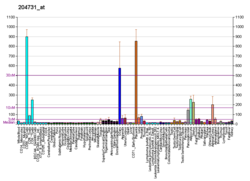Betaglycan also known as Transforming growth factor beta receptor III (TGFBR3), is a cell-surface chondroitin sulfate / heparan sulfate proteoglycan >300 kDa in molecular weight. Betaglycan binds to various members of the TGF-beta superfamily of ligands via its core protein, and bFGF via its heparan sulfate chains. [5] [6] TGFBR3 is the most widely expressed type of TGF-beta receptor. Its affinity towards all individual isoforms of TGF-beta is similarly high and therefore it plays an important role as a coreceptor mediating the binding of TGF-beta to its other receptors - specifically TGFBR2. The intrinsic kinase activity of this receptor has not yet been described. In regard of TGF-beta signalling it is generally considered a non-signaling receptor or a coreceptor. [7] [8] By binding to various member of the TGF-beta superfamily at the cell surface it acts as a reservoir of TGF-beta. [6]
Contents
Study of a mouse knock-out for the Tgfbr3 gene showed a fundamental effect on the correct development of organs and the overall viability of the animals used. Within the same study, no significant changes in Smad signalling (typical for TGF-beta cascade) were detected. This fact suggests that additional, as yet undescribed functions of betaglycan may be mediated by non-classical signalling pathways. [7]




